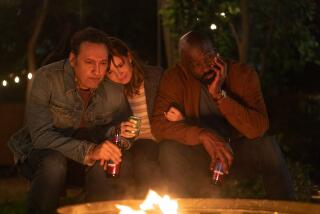‘The Leftovers’ recap: ‘I didn’t try hard enough’
- Share via
When children are young and their brains are expanding, they slowly come to understand causality and, with that understanding, begin to ask seemingly endless questions about their surroundings. Anecdotally, the most popular question is “Why?”
Once kids understand that there are reasons for nearly everything under the sun, they’re anxious to understand what they are. “Why is the sky blue?” “Why are my eyes brown?” “Why does Trevor have a nicer house than us?” “Why doesn’t everyone have a place to live?” Some answers come more easily than others, but some questions don’t have answers at all -- a fact that stymies not just children, but adults.
This, ultimately, is the crux of Damon Lindelof’s career: People asking “why” and him not always having a satisfying answer for them, an idea that I look at in more detail here. But as HBO’s “The Leftovers” begins its second season, the people behind the show are becoming more comfortable with embracing the lack of “why,” and hoping the audience is willing to embrace that with them.
SIGN UP for the free Classic Hollywood newsletter >>
Which is why the episode started with a cavewoman, I assume.
Welcome to the second season of “The Leftovers,” a show in which, instead of offering audiences the answers they demanded, Lindelof provides a 10-minute opening sequence centered around a doomed cavewoman. It’s a choice that, in a single moment, sets the tone for the whole of the season to come. Though “Leftovers” took care to address some of the criticisms made after the first season -- namely that it was, unnecessarily, a predominantly Caucasian show -- it has no interest in becoming the show that some would have it be.
When I spoke with Lindelof in anticipation of the new season, it became clear he had little interest in explaining away the mysteries inherent in “The Leftovers” narrative. As he said of reading Tom Perrotta’s book and thinking, “‘You can do that?’ You can say, ‘I’m not telling.’ What a liberating idea that is.”
Though the first season of “The Leftovers” was capable of great things, it was, if nothing else, inconsistent. Part of that was a reflection of the stories being told, featuring characters still locked in the struggle of “why” the departure happened -- stories that left the audience just as focused on the elusive answer to that question as were the individuals struggling with it.
But Season 2 has shifted away from “why” and moved toward “how,” as in: How will the characters find a life worth living knowing that answers will never be forthcoming.
The title of the second-season premiere is “Axis Mundi,” a place that, in certain belief systems, acts as a celestial pole, the connection of heaven and Earth, where messages may ascend and disseminate. With this title, the series suggests that Miracle may indeed be the axis mundi, the navel of the world.
If that’s true, then what’s the actual implication of the cavewoman opening? That the true human inheritance is that of death and loss? Or that even in the face of such destruction, humans find a way to protect each other, regardless of blood?
Central to the new-and-improved “Leftovers” is the Murphy family, with whom the bulk of “Axis Mundi” is concerned. On the surface, the family is a model multi-camera sitcom family. Mom Erika is a small-town doctor and dad John is a firefighter. Twins Evie and Michael couldn’t be more different but somehow everyone manages to get along like gangbusters.
John in particular is one step removed from a sitcom parody. He sleeps so deeply, family members are able to stack things on him without him waking! He always wants more bacon! He’s obsessed with finding a tricky cricket that always manages to elude him!
And he’s an arsonist. An ex-convict who was behind bars for attempted murder, an incident he explains by saying he “didn’t try hard enough.” John is the danger, and he’s just the beginning.
There are a number of levels in which the Season 2 premiere is a profoundly adept episode of television, but perhaps none is so unnerving as is the way in which Lindelof and his team manage to make everything in the episode both welcoming and deeply discomfiting.
In presenting the Murphy family as what they are, an almost obnoxiously loving family, it only serves to make their abnormalities more monstrous. There is something rotten lurking deep within the family and the community, making “Axis Mundi” the best “Twin Peaks” episode that never was.
Though something such as “The Twilight Zone” might suggest that the message was hidden within the mystery, “The Leftovers,” like “Twin Peaks” before it, suggests that the mystery is the message and that those things that are unknowable are the ones that should frighten you most.
Additionally, by not featuring the proto-Garveys (the makeshift family unit made up of returning regular characters Kevin Garvey (Justin Theroux), Nora Durst (Carrie Coon), Jill Garvey (Margaret Qualley) with their foundling baby) until three-quarters of the way through the premiere, Lindelof and co-creator Perrotta underline the fact that the show isn’t about how the departure has influenced any one person specifically, but how every individual is touched in profoundly different ways.
The move to Jarden, Texas, also known as Miracle, offers a completely different point of view on post-departure life. The town became a national park after making it through the departure without losing a single soul, thereby shifting the focus of the series to individuals who made it through the event untouched and how the price they pay for their security may be just as expensive as the toll taken on those who suffered grave losses.
Moreover, it’s a scathing examination of the liberties we find ourselves willing to exchange for some semblance of security, and how comfortable people can become building walls to keep others out of their space.
Though we only see it in bits and pieces, Miracle is clearly a messy amalgamation of elements, part shrine, part tourist trap, all accurate representation of what a modern interpretation of holy ground might be.
It’s the perfect representation of the often uneasy relationship culture has with the idea of religious salvation. Pilgrims visit Miracle in search of an assurance that in this place, they can find safety. They’re even willing to pay for it, if necessary. What no one is interested in, as is clear from the visitors uninterested in the souvenir spring water, is the idea that grace that doesn’t come with a guarantee.
We’re one episode into the new season and already the mysteries are piling up. What lies beneath Jarden that causes the Earth such unrest? Where has Evie disappeared to? Why was Miracle spared? What’s really going on with the fire department, and what’s John’s actual job title? Why were there naked teenagers running through the forest? What was with that tiny bird buried in a box? Why are the proto-Garveys here and how long will they stay?
In this way, “The Leftovers” acts as a fun-house mirror. So many of the individuals wandering around in the wake of the departure are still looking for answers, for guarantees. They, like the audience -- whose heads are already spinning with questions they ache for answers to -- are better off returning to the struggle of toddlers everywhere: Sometimes there aren’t answers to the questions we ask. And there’s nothing wrong with that.
Follow me on Twitter at @midwestspitfire
More to Read
The complete guide to home viewing
Get Screen Gab for everything about the TV shows and streaming movies everyone’s talking about.
You may occasionally receive promotional content from the Los Angeles Times.







